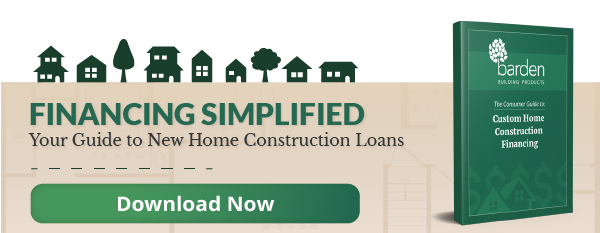
Most people only build a custom home once in their lives. Because of this, unfortunately some prospective homeowners are blinded by unexpected costs that they failed to budget for before building begins.
We put together this guide to help homeowners expect the unexpected, and account for every aspect of home building that might arise.
In this guide, we’ll be referring to the total dollar amount spent during building as being broken into two categories: hard costs and soft costs. Additionally, we’ll explore various factors that can affect cost.
But first, a note on costs: Depending on your personal budget and build goals, there are a few cost ranges you will fall between. In general, these can be best referred to as economy, modest, custom, and luxury. It’s important to match each material and product choice to the category that your overall build falls in. This is explained further in Owner Builder’s Home Budget Guide.
5 Sneaky Soft Costs to Be Mindful Of
To put it simply, soft costs are all costs that are not classified as direct construction costs, meaning they are out of pocket expenses. One way to mitigate these costs is by taking advantage of our in-house design services. The two main categories that homeowners recognize as being soft costs are paperwork/ fees and movable furniture.
Here are 5 of these costs that commonly sneak up on homeowners:
- Architectural and Design Fees
- Inspection Fees and Permits
- Land and Real Estate Costs
- Loan Fees
- Taxes on Materials and Services
1. Architectural and Design Fees
It’s common for homeowners to spend about 10-15% of their overall home building budget on architect and design fees. This is a staggering figure, as what is included in the price of an architect varies depending on the architect of choice.
One way to save both money (and headaches) is to build with an organization, such as Barden Building Products, that includes design work in the cost of the build package. Not only does this save a large portion of money, but it helps to streamline the process when the designers are working directly with the customer.
2. Inspection Fees and Permits
Paperwork can be a pain, but it is necessary to ensure that your house is built right the first time, and in accordance with local zoning and building codes. Along with this important paperwork, though, is a price tag.
It’s important to factor in the cost of arranging the inspections, acquiring the permits, and the experts it takes to do so. Your home builder is your best asset in advising how much these items tend to cost homeowners in your area.
When working with Barden Building Products for your home building project, our team if independent dealers quote inspection and permit fees, as well as taxes.
3. Land and Real Estate Costs
In order to build your custom home, you logically must have land to build on. The cost of procuring that land, as well as real estate costs for the assistance in finding and procuring the land, must be accounted for in the final price of the home building project.
4. Loan Fees
It’s extremely uncommon for a new homeowner to pay out of pocket for all of these expenses. Most likely, you’ll be taking out a loan as a financing option for making your dream home a reality.
We offer a Consumer Guide to Construction Financing that dives a little bit deeper into what type of loan is available, and what the financing process most commonly looks like.
5. Taxes on Materials and Services
It is so important to account for tax when selecting your materials, as well as your subcontractors and service providers. This is one of the most common soft costs that new homeowners fail to account for.
When drafting your budget, be sure to look at the total cost after tax of all of your materials -- rather than the retail or square footage price of what you’ve selected.
5 Important Hard Costs to Budget For
Hard costs, put simply, include all of the labor and materials used to build the house, as well as site work for preparing the lot for building.
These costs are based on the architectural drawings and include:
- Excavation and Foundation
- Building Structure
- Site Work
- Landscaping
- Change Orders
In general, hard costs are not as forgotten about as soft costs since they are easier to estimate and follow the standard elements of budgeting that homeowners are used to. With that being said, these hard costs still sometimes take homeowners by surprise.
1. Excavation and Foundation
After the land is selected, important steps must be taken to prepare for build, including excavation. Though it is true that every single build site must undergo a degree of excavation and foundation preparation, some sites are more costly than others.
When selecting land, it’s prudent to keep in mind the “buildability” of the land in the price. While less expensive land might seem great upfront, if substantial excavation and prep is needed, it may end up being more expensive in the long run.
Additionally, the foundation itself has different costs associated based on homeowner selection. Full concrete, concrete slabs, concrete crawl spaces, and more all have different budget considerations.
2. Building Structure
This cost includes ALL labor and material that is required to complete the structure.
It is common for home owners to only factor in material costs, while neglecting to consider the labor.
3. Site Work
Separate from the initial site work, the following factors must be considered:
- All utilities (sewer, water, electric, gas) installation
- HVAC systems
- Paving
- Grading
- Drainage
The material for the aforementioned materials is also included in the hard costs, NOT just the cost of installation.
4. Landscaping
Not all homeowners opt for landscaping during their initial builds. But those who have included landscaping elements on their architectural drawings need to be mindful of the cost of grass, trees, gravel, mulch, fertilizer, and any more as applicable.
5. Change Orders
This is a home building catch-all term for any additional expenses related to the construction of the home.
Oftentimes, this can include insurance costs and additional material costs. What is included in the change order costs varies from home builder to home builder -- so be sure to open up the lines of communication early and inquire about what items may be included.
Ensure that you are working with a builder that you trust, as sometimes unnecessary costs will accrue here if the builder has quoted your build with a lower price with the goal of making up for the missed revenue with change orders. If you’re seeing an unusually high number of change orders, it’s a sign your builder is not reputable.
When utilizing the panel building process, the chance for large change orders is minimized due to the exact amount of materials needed being calculated by engineering in advance. Rather than utilizing estimations that change hands throughout the building process, we utilize advanced software and experts throughout that guide the project along the way.
Additional Elements That Can Affect Cost:
The following factors can commonly impact budget, and should be fleshed out early on in the process:
- Size of the home, square footage
- Number of stories on the home
- Shape
- Type of roof
- Type of siding
- Fixtures and interior finishes
- Appliances
- Design features such as decks, pools, patios, etc.
Partner with the Right People
What affects home price more than anything is your choice of builder. Avoid unnecessary costs and streamline your custom home build with an efficient, panel building process orchestrated by a company with decades of experience.
Take this information with you! Download our Consumer Guide to Construction Financing:


